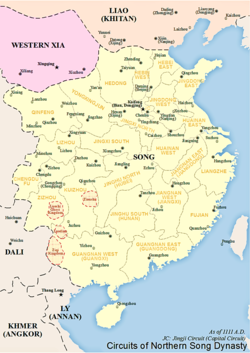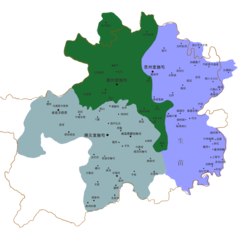Chiefdom of Sizhou
Chiefdom of Sizhou | |||||||
|---|---|---|---|---|---|---|---|
| 582–1413 | |||||||
 Chiefdom of Sizhou in 1100 A.D. (Tianshi = Chiefdom of Sizhou) | |||||||
 Sizhou in purple and Bozhou in green | |||||||
| Status | Native Chiefdom of China | ||||||
| Capital | Sizhou (modern Cengong) | ||||||
| Common languages | Tujia, Chinese, Hmong | ||||||
| Religion | Nuoism, later also Confucianism | ||||||
| Government | Monarchy | ||||||
| Chieftain | |||||||
• 582–626 | Tian Zongxian (first) | ||||||
• 1387–1413 | Tian Chen (last) | ||||||
| History | |||||||
• Established | 582 | ||||||
• independence of Sinan | 1364 | ||||||
• Annexed by Ming China | 1413 | ||||||
| |||||||
| Today part of | China | ||||||
Chiefdom of Sizhou (Chinese:
Sizhou, Bozhou, Shuidong and Shuixi were called "Four Great Native Chiefdom in Guizhou" (贵州
Origin
[edit]The Tian clan claimed to be descendants of Han Chinese in their genealogy book; however the authenticity needed to be verified. Modern scholars stated that Tian Zongxian was either Han Chinese[2] or Tujia.[3]
History
[edit]The Chiefdom of Sizhou was established during the Sui dynasty when the first chieftain Tian Zongxian occupied Qianzhong area (黔中, modern-day eastern Guizhou) in southwest China. It lasted for about 831 years over 26 generations through the Sui, Tang, Song, Yuan, and Ming dynasties.[2][4]
In 1107, Sizhou chieftain Tian Yougong (
In 1364, Chiefdom of Sinan declared its independence from Sizhou. Tian Mao'an (
However, the two clans had been feuding ever since, they were waging an endless war. Sizhou attacked Sinan in 1411, Tian Zongding (
List of Sizhou chieftains
[edit]Below are Sizhou chieftains[3][4]
| No. | Name | Chinese | Reign | Notes |
|---|---|---|---|---|
| 1 | Tian Zongxian | 582–626 | ||
| 2 | Tian Weikang | 626–660 | eldest son of Tian Zongxian | |
| 3 | Tian Yangming | 660–? | eldest son of Tian Weikang | |
| 4 | Tian Kechang | ?–711 | son of Tian Yangming | |
| 5 | Tian Daoyuan | 711–729 | eldest son of Tian Kechang | |
| 6 | Tian Gongrong | 729–773 | son of Tian Daoyuan | |
| 7 | Tian Zailong | 773–? | son of Tian Gongrong | |
| 8 | Tian Shifeng | ?–870 | son of Tian Zailong | |
| 9 | Tian Zuoyu | 870–? | third son of Tian Shifeng | |
| 10 | Tian Fengxiang | ?–? | son of Tian Zuoyu | |
| 11 | Tian Chengwen | ?–? | eldest son of Tian Fengxiang | |
| 12 | Tian Zhengyun | ?–? | son of Tian Chengwen | |
| 13 | Tian Shiru | ?–1098 | son of Tian Zhengyun | |
| 14 | Tian Yougong | 1098–1135 | eldest son of Tian Shiru | |
| 15 | Tian Rurui | 1135–? | eldest son of Tian Yougong | |
| 16 | Tian Zuheng | ?–1224 | eldest son of Tian Rurui | |
| 17 | Tian Zonghan | 1224–? | son of Tian Zuheng | |
| 18 | Tian Qingyu | ?–1275 | son of Tian Zonghan | |
| 19 | Tian Xinglong | 1275–? | son of Tian Qingyu | |
| 20 | Tian Yingbing | ?–1278 | eldest son of Tian Xinglong | |
| 21 | Tian Jingxian | 1278–? | also known as Tian Jinxian ( son of Tian Yingbing | |
| 22 | Tian Weiyong | ?–1365 | eldest son of Tian Jingxian | |
| 23 | Tian Maolie | 1365–? | son of Tian Weiyong | |
| 24 | Tian Renhou | ?–1369 | eldest son of Tian Maolie Sinan declared independence in 1364 | |
| 25 | Tian Hongzheng | 1369–1387 | son of Tian Renhou | |
| 26 | Tian Chen | 1387–1413 | son of Tian Hongzheng executed by Yongle Emperor in 1413 |
References
[edit]- ^ 颜丙
震 (June 2018).明 后 期 黔蜀毗邻地区 土 司 纷争研究 (in Chinese). ISBN 9787511555625. - ^ a b c "
思 州 土 司 的 前世 今朝 :田 氏 传奇八 百 年 土 司 文化 传后代 " (in Chinese). people.com.cn. - ^ a b c
黄 透 松 (1991). "思 州 田 氏 世 系 初 考 ". 贵州文 史 丛刊 (in Chinese) (1). - ^ a b c 瞿政
平 . "铜仁古代 史 与 思 州 田 氏 土 司 " (in Chinese). 铜仁日 报. - ^ a b "
田 氏 思 州 三 驻龙泉 坪 " (in Chinese). trxw.gov.cn. Archived from the original on 2019-12-17. Retrieved 2019-12-20. - ^ "Taizong Shilu". Ming Shilu (in Chinese). Vol. 137.
- ^ "历史
沿革 ". People's Government of Guizhou Province. Retrieved 20 December 2019.
